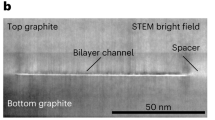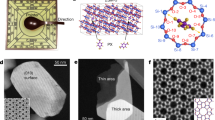Abstract
Molecular movement in confined spaces is of broad scientific and technological importance in areas ranging from molecular sieving and membrane separation to active transport through ion channels. Whereas measurements of ensemble diffusion provide information about the overall behaviour of the guest in a porous host, tracking individual molecules provides insight into both the heterogeneity and the mechanistic details of molecular diffusion as well as into the structure of the host. Here, we show how single dye molecules can be used as nanoscale probes to map out the structure of mesoporous silica channel systems prepared as thin films via cooperative self-assembly of surfactant molecules with polymerizable silicate species. The dye molecules act as beacons while they diffuse through the different structural phases of the host: the structure of the trajectories, the diffusivities and the orientation of single molecules are distinctive for molecules travelling in the lamellar and the hexagonal mesophases. These experiments reveal unprecedented details of the host structure, its domains and the accessibility as well as the connectivity of the channel system.
This is a preview of subscription content, access via your institution
Access options
Subscribe to this journal
Receive 12 print issues and online access
$259.00 per year
only $21.58 per issue
Buy this article
- Purchase on Springer Link
- Instant access to full article PDF
Prices may be subject to local taxes which are calculated during checkout





Similar content being viewed by others
References
Beck, J. S. et al. A new family of mesoporous molecular sieves prepared with liquid crystal templates. J. Am. Chem. Soc. 114, 10834–10843 (1992).
Zhao, D. et al. Triblock copolymer syntheses of mesoporous silica with periodic 50 to 300 angstrom pores. Science 279, 548–552 (1998).
Choi, M. & Ryoo, R. Ordered nanoporous polymer-carbon composites. Nature Mater. 2, 473–476 (2003).
Grosso, D. et al. Periodically ordered nanoscale islands and mesoporous films composed of nanocrystalline multimetallic oxides. Nature Mater. 3, 787–792 (2004).
Sun, D. et al. Hexagonal nanoporous germanium through surfactant-driven self-assembly of Zintl clusters. Nature 441, 1126–1130 (2006).
Trikalitis, P. N., Rangan, K. K., Bakas, T. & Kanatzidis, M. G. Varied pore organization in mesostructured semiconductors based on the [SnSe4]4− anion. Nature 410, 671–476 (2001).
De Vos, D. E., Dams, M., Sels, B. F. & Jacobs, P. A. Ordered mesoporous and microporous molecular sieves functionalized with transition metal complexes as catalysts for selective organic transformations. Chem. Rev. 102, 3615–3640 (2002).
Billinge, S. J. L. et al. Mercury binding sites in thiol-functionalized mesostructured silica. J. Am. Chem. Soc. 127, 8492–8498 (2005).
Rebbin, V., Schmidt, R. & Fröba, M. Spherical particles of phenylene-bridged periodic mesoporous organosilica for high-performance liquid chromatography. Angew. Chem. Int. Edn Engl. 45, 5210–5214 (2006).
Cott, D. J. et al. Preparation of oriented mesoporous carbon nano-filaments within the pores of anodic alumina membranes. J. Am. Chem. Soc. 128, 3920–3921 (2006).
Ye, B., Trudeau, M. L. & Antonelli, D. M. Observation of a double maximum in the dependence of conductivity on oxidation state in potassium fulleride nanowires supported by a mesoporous niobium oxide host lattice. Adv. Mater. 13, 561–565 (2001).
Petkov, N., Stock, N. & Bein, T. Gold electroless reduction in nanosized channels of thiol-modified SBA-15 material. J. Phys. Chem. B 109, 10737–10743 (2005).
Ryoo, R., Joo, S. H., Kruk, M. & Jaroniec, M. Ordered mesoporous carbons. Adv. Mater. 13, 677–681 (2001).
Lai, C.-Y. et al. A mesoporous silica nanosphere-based carrier system with chemically removable CdS nanoparticle caps for stimuli-responsive controlled release of neurotransmitters and drug molecules. J. Am. Chem. Soc. 125, 4451–4459 (2003).
Roy, I. et al. Optical tracking of organically modified silica nanoparticles as DNA carriers: A nonviral, nanomedicine approach for gene delivery. Proc. Natl Acad. Sci. 102, 279–284 (2005).
Terasaki, O. & Ohsuna, T. in Handbook of Zeolite Science and Technology (eds Auerbach, S. M., Carrado, K. A. & Dutta, P. K.) 291–315 (Dekker, New York, 2003).
Kukla, V. et al. NMR studies of single-file diffusion in unidimensional channel zeolites. Science 272, 702–704 (1996).
Benes, N. E., Jobic, H. & Verweij, H. Quasi-elastic neutron scattering study of the mobility of methane in microporous silica. Micropor. Mesopor. Mater. 43, 147–152 (2001).
Rigler, R., Mets, Ü., Widengren, J. & Kask, P. Fluorescence correlation spectroscopy with high count rate and low background: Analysis of translational diffusion. Eur. Biophys. J. 22, 169–175 (1993).
Wirth, M. J., Swinton, D. J. & Ludes, M. D. Adsorption and diffusion of single molecules at chromatographic interfaces. J. Phys. Chem. B 107, 6258–6268 (2003).
Bacia, K., Kim, S. A. & Schwille, P. Fluorescence cross-correlation spectroscopy in living cells. Nature Methods 3, 83–89 (2006).
Fu, Y., Ye, F., Sanders, W. G., Collinson, M. M. & Higgins, D. A. Single molecule spectroscopy studies of diffusion in mesoporous silica thin films. J. Phys. Chem. B 110, 9164–9170 (2006).
Werley, C. A. & Moerner, W. E. Single-molecule nanoprobes explore defects in spin-grown crystals. J. Phys. Chem. B 110, 18939–18944 (2006).
Roeffaers, M. B. J. et al. Spatially resolved observation of crystal-face-dependent catalysis by single turnover counting. Nature 439, 572–575 (2006).
Hellriegel, C. et al. Diffusion of single streptocyanine molecules in the nanoporous network of sol-gel glasses. J. Phys. Chem. B 108, 14699–14709 (2004).
McCain, K. S., Hanley, D. C. & Harris, J. M. Single-molecule fluorescence trajectories for investigating molecular transport in thin silica sol-gel films. Anal. Chem. 75, 4351–4359 (2003).
Tardin, C., Cognet, L., Bats, C., Lounis, B. & Choquet, D. Direct imaging of lateral movements of AMPA receptors inside synapses. EMBO J. 22, 4656–4665 (2003).
Seisenberger, G. et al. Real-time single-molecule imaging of the infection pathway of an adeno-associated virus. Science 294, 1929–1932 (2001).
Jung, C. et al. A new photostable terrylene diimide dye for applications in single molecule studies and membrane labeling. J. Am. Chem. Soc. 128, 5283–5291 (2006).
Brinker, C. J., Lu, Y., Sellinger, A. & Fan, H. Evaporation-induced self-assembly: Nanostructures made easy. Adv. Mater. 11, 579–585 (1999).
Zhao, D., Huo, Q., Feng, J., Chmelka, B. F. & Stucky, G. D. Nonionic triblock and star diblock copolymer and oligomeric surfactant syntheses of highly ordered, hydrothermally stable, mesoporous silica structures. J. Am. Chem. Soc. 120, 6024–6036 (1998).
Hellriegel, C., Kirstein, J. & Bräuchle, C. Tracking of single molecules as a powerful method to characterise diffusivity of organic species in mesoporous materials. New J. Phys. 7, 1–14 (2005).
Dickson, R. M., Norris, D. J. & Moerner, W. E. Simultaneous imaging of individual molecules aligned both parallel and perpendicular to the optic axis. Phys. Rev. Lett. 81, 5322 (1998).
Seebacher, C., Hellriegel, C., Bräuchle, C., Ganschow, M. & Wöhrle, D. Orientational behavior of single molecules in molecular sieves: A study of oxazine dyes in AlPO4-5 crystals. J. Phys. Chem. B 107, 5445–5452 (2003).
Saxton, M. J. & Jacobson, K. Single-particle tracking: Applications to membrane dynamics. Annu. Rev. Biophys. Biomol. Struct. 26, 373–399 (1997).
Einstein, A. Über die von der molekularkinetischen Theorie der Wärme geforderte Bewegung von in ruhenden Flüssigkeiten suspendierten Teilchen. Ann. Phys. 17, 549–560 (1905).
Acknowledgements
We would like to thank K. Müllen (MPI für Polymerforschung, Mainz, Germany) for kindly providing the TDI dye, N. Rauhut for the assistance with the measurements and P. Schwaderer for the AFM data. This work was financially supported by the Sonderforschungsbereich SFB-486.
Author information
Authors and Affiliations
Corresponding author
Ethics declarations
Competing interests
The authors declare no competing financial interests.
Supplementary information
Supplementary Information
Supplementary figures and movie captions (PDF 442 kb)
Supplementary Information
Supplementary movie S1 segment 1 (AVI 3552 kb)
Supplementary Information
Supplementary movie S1 segment 2 (AVI 3443 kb)
Supplementary Information
Supplementary movie S2 (AVI 1818 kb)
Supplementary Information
Supplementary movie S3 (AVI 2771 kb)
Supplementary Information
Supplementary movie S4 (AVI 127 kb)
Supplementary Information
Supplementary movie S5 segment 1 (AVI 2911 kb)
Supplementary Information
Supplementary movie S5 segment 2 (AVI 2863 kb)
Supplementary Information
Supplementary movie S5 segment 3 (AVI 2662 kb)
Supplementary Information
Supplementary movie S6 (AVI 3100 kb)
Supplementary Information
Supplementary movie S7 (AVI 609 kb)
Supplementary Information
Supplementary movie S8 (AVI 1442 kb)
Supplementary Information
Supplementary movie S9 (AVI 2464 kb)
Supplementary Information
Supplementary movie S10 (AVI 2397 kb)
Supplementary Information
Supplementary movie S11 (AVI 2271 kb)
Rights and permissions
About this article
Cite this article
Kirstein, J., Platschek, B., Jung, C. et al. Exploration of nanostructured channel systems with single-molecule probes. Nature Mater 6, 303–310 (2007). https://doi.org/10.1038/nmat1861
Received:
Accepted:
Published:
Issue Date:
DOI: https://doi.org/10.1038/nmat1861
This article is cited by
-
Pulsed field gradient NMR diffusion measurement in nanoporous materials
Adsorption (2021)
-
Single-molecule observation of diffusion and catalysis in nanoporous solids
Adsorption (2021)
-
Diffusion in nanopores: inspecting the grounds
Adsorption (2021)
-
Optical super-resolution microscopy and its applications in nano-catalysis
Nano Research (2015)
-
Single-molecule diffusion and conformational dynamics by spatial integration of temporal fluctuations
Nature Communications (2014)



